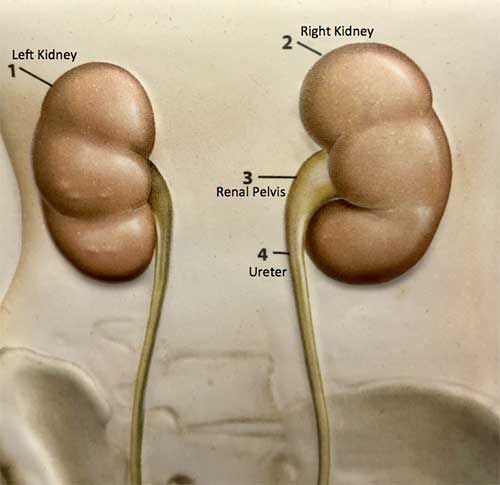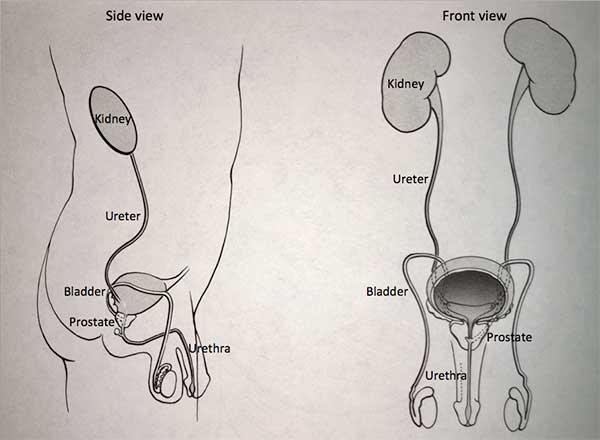Cancer of the Ureter/Renal Pelvis (Transitional Cell Carcinoma)
The urinary tract begins with the kidneys. The kidneys, one on each side, sit high in the upper abdomen partially underneath the rib cage.

They filter the blood to extract excess waste products and fluid to form the urine. Urine, once formed in the kidneys, is collected in the renal pelvis, the first part of the urinary drainage system. Urine travels through a tube on each side, the ureter, down to the bladder. Urine is constantly being made by the kidneys and transported through the ureters into the bladder. The bladder stores urine until full and then empties to the outside through the urethra. The urinary system is the same in both men and women from the kidneys to the bladder. In men, the urethra is longer and encircled by the prostate which is a gland that is part of the reproductive system, forms the first part of the urethra.

The lining of the urinary system is made up of specialized cells called transitional cells. These cells are designed to pass urine without absorbing toxins from the urine. When these cells become cancerous, it is called transitional cell carcinoma. Transitional cell carcinoma can occur in the renal pelvis, the ureter, or the urinary bladder.
Risk factors
It is not always clear what causes transitional cell cancers to form. Cigarette smoking and exposure to industrial chemicals are clearly defined risk factors. Cigarette smoking alone has been estimated to cause 50% of all transitional cell cancers. Workplace exposure to chemical compounds such as paints and solvents may cause another 20-25% of transitional cell cancer cases.
When there is a history of transitional cell carcinoma elsewhere, such as bladder cancer, there may be an increased risk of developing cancer of the renal pelvis or ureter. Some less common factors which may predispose to the formation of cancer to the renal pelvis or ureter include Balkan ancestry, analgesic (phenacetin) abuse, occupational exposures (chemical, petrochemical, plastics, coal, asphalt, tar), chronic irritation from infection or stones, cyclophosphamide chemotherapy, and use of contaminated Chinese herbs and family history (eg Lynch Syndrome II).
Symptoms
Blood in the urine (hematuria), either microscopic or seen with the naked eye (gross hematuria), is the most common symptom. Back or flank pain or kidney infection may also be symptoms.
Diagnosis
Evaluation of the urinary collecting system usually involves urine studies, blood work, imaging such as CT scan with intravenous contrast and cystoscopy, an office procedure to look in the bladder. Evaluating the ureter and renal pelvis may include surgery called ureteroscopy to look in the collecting system.
If suspicious areas are seen, biopsies may be taken and a plastic tube called a stent may be left in place to let the kidney drain while the biopsy site heals. The stent is typically left in place for about a week then removed via cystoscopy in the office.
Management
If transitional cell carcinoma is diagnosed in the collecting system, surgery is often indicated. This may involve removal of the affected kidney, ureter and small portion of the bladder.
If the segment is short and the cancer is not too aggressive, sometimes just a segment of the ureter can be removed. Follow up will be necessary for years to make sure cancer does not appear in transitional cells in the rest of the urinary system.
Additional Information
Robotic Surgery for Ureteral Tumor in a Patient with Two Right Ureters
Contact us to request an appointment or ask a question. We're here for you.


